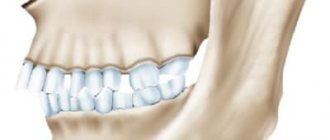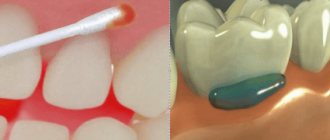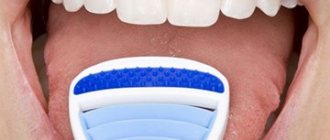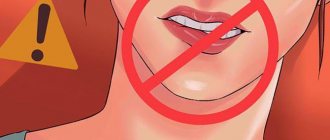The diagnosis of macroglossia is made if the tongue becomes excessively enlarged and thickened. With macroglossia, this muscular organ is pathologically changed or has some anomalies in its structure. This usually occurs due to developmental disorders of the fetus or is a consequence of some pathological process in the body. With this disease, the tongue becomes covered with folds, which further interfere with its proper dynamics. More often the disease occurs in childhood.
If the normal weight of the tongue is from 60 to 80 grams, then with this pathology it “grows” to 120 grams or more.
Both the entire organ and its individual parts (lateral surfaces, back or tip) can increase in size. Because of this, teeth marks may be imprinted on it. Often the tongue may not fit in the mouth and protrude outward.
Causes
Macroglossia can be either a local (local) manifestation or have a generalized nature. This disease can occur in many pathologies of the human body. As an independent disease, macroglossia can occur when:
- inflammation involving the lingual area (low glossitis of the tongue):
- rhinoscleroma with spread to the upper respiratory tract;
- open bite;
- acute angioedema;
- with the accumulation of pus due to an abscess in the oral cavity;
- a progressive cyst or tumor with damage to blood vessels (lymphatic or circulatory);
- hemorrhages accompanied by a rush of blood to the lingual tissue;
- “neurologically flaccid” tongue syndrome;
- impaired venous or lymphatic drainage in the lingual tissue;
- oral candidiasis.
However, macroglossia often occurs with such serious congenital damage to the body as:
- cretinism or other organic brain abnormalities;
- genetic disorders (Down syndrome, etc.);
- hypofunction of the thyroid gland and the development of myxedema;
- acromegaly.
Also, increased sizes of tongue tissue can accompany metabolic diseases such as:
- amyloidosis (deposition of amyloid in the tongue, when it becomes waxy, dense, with smoothed papillae);
- glycogenosis;
- pellagra (tongue red and ulcerated).
Often, forward displacement of the tongue can be observed in children as a consequence of their bad habit of tongue sucking.
Macroglossia is sometimes misdiagnosed in people with a small lower jaw.
The disease is often called “constitutional”, as it is common in obese men who have an increased love for food.
Macroglossia also occurs in severe infectious diseases such as tuberculosis or syphilis.
Exercises
The lengthening of the tongue depends on the condition of the hyoid frenulum.
If it is not developed and is short, then the following exercises should be used:
- “Mushroom” - you need to open your mouth wide and smile. Then suck your tongue to the roof of your mouth so that the tip does not curl up. And you still need to smile. Exercises should be done for one minute, then increase the time every day. This way, the ligament will gradually stretch and will not be damaged.
- “Painter” - you need to open your mouth and smile. Run the tip of your tongue across the roof of your mouth from your teeth to your throat and back. And this needs to be done several times without moving the lower part of the jaw.
- Smiling, open your mouth. You need to stretch your tongue to your nose, then to your upper lip. The tongue should not be constricted; it should be in a relaxed state. It won't work out right away, but over time everything will work out. During this exercise, you need to make sure that your lips and lower jaw do not move.
- Smiling, place your tongue as in the “Mushroom” exercise and open and close your mouth. There may be some pain in the ligament area, but this is normal as this exercise helps stretch the hyoid ligaments.
- “Horse” - you need to put your tongue in the “Mushroom” position and click your tongue, as if imitating the clopping of a horse. You have to suck your tongue and click, suck and click. In this exercise, only the tongue works, the lower jaw is motionless.
- "Kitty". This exercise is reminiscent of how a cat laps milk. So a person needs to try this, sticking his tongue out.
All these exercises will bring results only when a person does them every day and several times.
If you don’t want to perform this complex, then you can simply stretch your tongue to your nose. This exercise should be done frequently over a long period of time. It’s not for nothing that they say: “If you suffer for a long time, something will work out.” Therefore, you need to put in as much effort as possible.
This is the main way to lengthen your tongue at home; exercises can be done at any age. Kids will be able to cope with them from the age of two years.
Symptoms
Macroglossia can be true or false. Sometimes abnormal development of the jaw arch is mistaken for an increase in lingual tissue. In case of recession or congenital narrowness of the jaw, this ailment is considered false. With true macroglossia, the tongue is enlarged by one and a half to two times. However, this form of the disease occurs rarely.
Macroglossia in newborns
It is important to identify this disease in a timely manner, as this will greatly affect the success of its treatment and the likelihood of it becoming chronic.
Therefore, it is especially important to identify such pathology during the neonatal period.
When examining a newborn, it is important not to miss such manifestations of the disease as:
- enlargement of the tongue when it protrudes beyond the mouth;
- “varnished” or dried surface;
- tuberosity, enlarged papillae;
- blocking of the larynx by the root of the tongue, which forces the baby to refuse food;
- slightly open mouth;
- labored breathing;
- excessive salivation;
- frequent attacks of asphyxia (breathing problems);
- frequent infection and increased body temperature;
- deterioration of general condition.
Very often, children in the first year of life experience a local form of the disease. Often tongue pathology occurs in the fetus for the following reasons:
- improper development;
- idiopathic diseases with symptoms of hypertrophy of the lingual muscles;
- the formation of cysts or cavities during the formation of the tongue muscles;
- with adverse factors affecting the pregnant woman’s body (intoxication, radiation, infections).
Forms
Photo: macroglossia
According to the different nature of the causes of this disease, medicine distinguishes its two forms: local or local, and generalized. Local (local) macroglossia occurs as a result of improper development of the circulatory system, which has no connection with general diseases of the body that lead to hypertrophy of the tongue.
Most often, this form occurs due to vascular formations of the tongue - lymphangioma or hemlymphangioma. The main location is the front part, but sometimes it is also observed on the root. Local macroglossia is typical for children of the first years of life
.
When additional infections and diseases occur, the tongue rapidly enlarges.
The generalized form of macroglossia occurs due to concomitant pathologies of the whole organism. For example, hemihypertrophy, hypothyroidism, Beckwith-Wiedemann syndrome. Characterized by enlargement of the tongue on one or both sides.
Manifestations of chronic macroglossia
Often, tongue enlargement that is not cured in time leads to a severe chronic course of the disease. In this case, in an adult, the following manifestations of this pathology can be identified:
- the volume of the tongue is significantly increased, its movements are limited;
- the mouth is constantly slightly open;
- the lingual surface is rough, often with cracks or blue bloody blisters, with increased bleeding;
- copious amounts of saliva;
- permanent injury to the tongue tissue from dental crowns;
- speech is slurred, unclear, pronouncing words with difficulty.
Carrying out diagnostics
It is best to diagnose macroglossia in utero. Currently, with ultrasound of the fetus, norms for the size of any of its organs at various stages of pregnancy have been developed. There are optimal sizes for the length and width of the tongue. Often, during intrauterine examination, protrusion of the tongue outside the mouth is noticeable.
The final conclusion is given by specialists after several ultrasound examinations over 1 – 2 months.
More often, a full diagnosis can be established only by the 30th week of pregnancy.
After the birth of a baby with this pathology, he will need a number of consultations with an ENT doctor, an infectious disease specialist, a geneticist, an endocrinologist, and an oncologist.
And only after a detailed examination (using clinical analysis and instrumental methods) is a treatment plan for the disease developed.
Lengthening methods
There are two ways to lengthen the tongue: the first way is surgery, that is, surgery; the second way is to lengthen the tongue at home with the help of exercises. True, the second method requires a long time and a lot of effort. To lengthen the tongue, they use a set of exercises that must be performed every day, otherwise there will be no result.
Consequences of macroglossia
Sometimes patients do not perceive macroglossia as a serious pathology and do not contact specialists in a timely manner. However, such a defect in the body as a large tongue can cause a person a lot of inconvenience and serious complications. First of all, the condition of the patient’s dentition is seriously disturbed. The tongue itself suffers from excessive dryness and is often injured and inflamed.
Also, an enlarged tongue interferes with the normal socialization of children, being a cosmetic defect. Most patients acquire psychological complexes.
After all, not all of their peers are ready to be friends with children whose tongues stick out, their speech is slurred, and there is also a constant flow of saliva from their mouths.
However, this is not all. With a long course, the disease often leads to the following pathologies of the body:
- breathing problems and the habit of breathing through the mouth;
- problems with diction (especially pronouncing hissing sounds);
- violation of the formation of the dentofacial apparatus with pathologies of the formation of dentition;
- digestive problems (the appearance of ulcers, colitis and gastritis) due to difficulties in chewing food.
In addition, an untreated disease causes pain and constant discomfort in the mouth. The tongue is inflamed, enlarged, stiff, and even subject to constant biting.
How to stretch the frenulum for children?
For infants, this procedure can be done in the maternity hospital: the surgeon cuts the baby’s frenulum without anesthesia and immediately after the operation they give the mother’s breast. Children aged 4-5 years undergo surgery and stitches, after which classes are held with a speech therapist. In order not to harm the child with exercises, you need to warn the speech therapist about the operation. Sometimes people learn about this problem already in adulthood. An adult can stretch the frenulum in the same way as a child. You need to devote a lot of time to studying. If a person decides to do such an act, then he needs to take it seriously. Exercises are performed 3 times a day, for 10-12 minutes.
The cause of this phenomenon has not yet been determined, but it could be heredity, pregnancy at a late age, or problems with intrauterine development.
Treatment
Treatment of macroglossia should be carried out taking into account the causes and factors that provoked the development of this disease. Specialists also take into account all changes (morphological or functional) that occurred during the course of the disease.
If an enlarged tongue is one of the manifestations of any disease, then paramount importance is given to the treatment of this “root cause” of the disease.
Drug treatment
If the disease occurs only locally (in the mouth), then drug treatment consists of local sanitation of the oral cavity and elimination of the cause of this disease.
If necessary, use general or local antibiotics, antiseptic and anti-inflammatory agents in the form of rinses or irrigations. Also, medications are necessarily used after surgery on the tongue to treat the wound and prevent secondary infection.
In addition, the drugs are also used for general diseases, when macroglossia is one of their symptoms. In this case, with the right treatment, the tongue shrinks on its own.
Surgical treatment
In severe cases of macroglossia, surgical treatment is more often used to correct the size of the tongue.
For such a radical method, there must be the following serious changes in the body:
- breathing problems;
- difficulty chewing and swallowing;
- serious aesthetic deviations in the facial area;
- open bite with the impossibility of using orthodontic treatment methods;
- constant drooling;
- speech therapy disorders (difficulty speaking and pronouncing sounds) that cannot be treated by a speech therapist.
During the operation, to normalize the size of the tongue, its wedge-shaped part is removed. In this case, the required part of the tongue is excised by a surgeon under general anesthesia, returning the organ to its normal size.
With an open bite, a prosthesis is usually installed to prevent the tongue from falling out of the mouth.
In cases of congenital form of the disease, children are often treated by ligation of the lingual arteries. This method slows down the growth of the tongue and allows you to restore optimal proportions.
In such cases, the prognosis for treating the disease is most often positive.
In case of tumor processes, treatment must be comprehensive, using surgical and chemotherapy methods, as well as drug and radiation therapy.
If you are diagnosed with macroglossia, you should not brush aside medical help and let everything take its course.
Indeed, in addition to constant discomfort in the mouth, people with a changed and enlarged tongue experience difficulties in communication, seriously worsening their own socialization. It is especially important to treat the disease as early as possible in children, preventing the occurrence of disorders in the dental apparatus and the formation of persistent psychological complexes in the child.
Sources used:
- Scully C, Porter S (July 2000). ABC of oral health. Swellings and red, white, and pigmented lesions"
- Perkins, J. A. (December 2009). "Overview of macroglossia and its treatment". Current Opinion in Otolaryngology & Head and Neck Surgery.
- "Therapeutic dentistry. Textbook" (Borovsky E. V.)
- “Diseases of the mucous membrane of the oral cavity and lips” (Bork K.)
Indications for surgery
Surgical intervention is not indicated in all cases of macroglossia development. Similar methods are used in the presence of certain factors:
- pathological respiratory dysfunction;
- complete disorder of the eating process;
- improper performance of speech function;
- for problems of an aesthetic nature;
- uncontrolled salivation;
- formed open bite. Only if it is impossible to correct an open bite using orthodontic systems.
Always remember that macroglossia is not just an unpleasant phenomenon that spoils a person’s appearance and causes pain. This is a pathology that leads to serious problems and irreversible consequences. Therefore, treatment must be timely and completed in full.
In conclusion, the video “Surgical treatment of macroglossia”:
If you find an error, please select a piece of text and press Ctrl+Enter.
Tags macroglossia language
Did you like the article? stay tuned
Previous article
Osteomyelitis of the jaw: types and methods of treatment
Next article
Plates for teeth straightening: types and nuances of application











